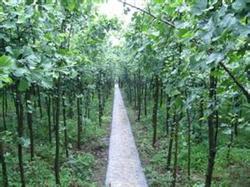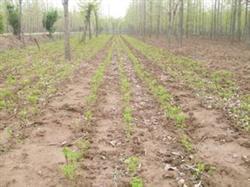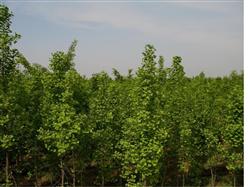Three-dimensional cultivation of Ginkgo biloba auricula

In recent years, the cultivation of ginkgo biloba has developed from traditional sporadic cultivation to production and intensification, and the area of leaf ginkgo garden and high-yield garden has increased year by year. Intercropping Auricularia auricula in the leaf-picking orchard of Ginkgo biloba, the fruiting body of Auricularia auricula breathes carbon dioxide to supplement the photosynthesis of Ginkgo biloba, which provides sufficient oxygen for the growth of Auricularia auricula, returning fungus bran to the field, fertilizing soil fertility and promoting the growth of Ginkgo biloba. Ginkgo biloba provides a cool climate for the growth of Auricularia auricula, and the two complement each other and achieve a bumper harvest. 1. Ginkgo cultivation 1. Build Ginkgo biloba leaf picking garden in order to obtain leaves with high quality and high yield. when building the garden, we should choose plots with leeward and sunny land, fertile land, convenient irrigation and drainage, deep ploughing and soil improvement, and sufficient organic fertilizer. 2. Ginkgo biloba seedlings with low crown, many branches, short internodes, dark leaves, thick and large leaves, high contents of ginkgo biloba flavonoids, bitter lactone and other active components should be selected for the construction of ginkgo biloba leaf orchard. Ginkgo biloba leaves are of high commercial value and can achieve the purpose of increasing production and income. 3. After the site of the ginkgo orchard (leaf picking garden) is selected, intensive cultivation and planting in rows along the north-south direction are beneficial to daylighting and ventilation. The planting method of ginkgo biloba is hole planting or furrow planting with a row spacing of 50 × 100 cm or 40 × 120 cm. The survival rate of ginkgo biloba colonization was the highest when the leaf buds were white before and after "Qingming". After planting, sufficient bottom water was irrigated to preserve soil moisture and promote seedling survival. 4. The main purpose of managing ginkgo leaf picking orchard is to harvest leaves. Strengthening underground management, control of diseases and insect pests, timely topdressing, foliar spraying and application of available nitrogen fertilizer are the key measures to increase the yield of ginkgo biloba leaves. 2. Fungus cultivation 1. Strain preparation: the seed production technology of Auricularia auricula is the same as that of conventional edible fungi. 2. Fungus management: the culture medium of Auricularia auricula can be adapted to local conditions, local materials can be used, and cottonseed hull or miscellaneous wood shavings can be used as culture medium. From April to May, the materials were mixed according to the formula of the culture medium, filled with low-pressure polyethylene bags, each bag was filled with about 150 grams, sterilized at room temperature for 10 hours, and the seeds were inoculated under aseptic conditions after cooling. After inoculation, the bags were stacked and sterilized indoors under aseptic ventilation conditions. 3. Auricularia auricula entering the garden: in June, the ginkgo leaf picking garden has a better shading effect, which is suitable for the growth and development of the fruiting body of Auricularia auricula. ① fungus into the garden: ginkgo leaf picking garden row spacing of 100cm or 120cm, two rows of auricularia auricula in each row. Combined with watering the ginkgo orchard, first pour enough bottom water into the planting ditch, wait for the water to penetrate, remove the bags of fungus, horizontally lay them horizontally in the planting ditch, or place the two bags in parallel longitudinally, cover the clot tightly after entering the ditch, cover it strictly, and then spray a flood, requiring it to be sprayed through. ② ear management: June to July, high temperature, high humidity, suitable for auricularia auricula growth, this period requires adhere to water spraying, to ensure humidity, prevention and control of diseases and insect pests, not flood irrigation, to spray carefully, spray frequently. After the fungus was put into the field, it took about 8 days for the fungus to come out of the ear, and the ear piece softened for 20 days after the fungus came out for 15 minutes, and it could be harvested. Auricularia auricula should be cleaned up in time after harvest (bacterial dregs, sundries), re-spray water out of the second stubble, a total of 3 MUE 4 stubble. From September to October, the growth of Auricularia auricula stopped before leaf picking, and the fungus bran was returned to the field combined with autumn ploughing to improve soil fertility. Comprehensive benefit Ginkgo biloba intercropping Auricularia auricula in leaf-picking nursery with good harvest. According to the experimental statistics, the income of ginkgo biloba per mu is 8600 yuan, the total income of Auricularia auricula is 6000 yuan, and the annual total income is more than 14600 yuan. At the same time, after returning fungus bran to the field, it increased the content of soil organic matter and beneficial microorganisms, improved the soil physical and chemical properties, and developed from traditional single planting to ecological agriculture, which is another new attempt in the comprehensive management of Ginkgo biloba.
- Prev

Drainage and irrigation management of Ginkgo biloba
In recent years, the production of Ginkgo biloba has developed rapidly, and there is a great demand for seedlings, but the breeding cycle of seedlings is long, which is not conducive to production. The use of cutting to raise seedlings can save seeds, avoid the grafting process, reduce the cost of raising seedlings, and the breeding speed is fast. It is reported that the treatment of Ginkgo biloba cuttings with low concentration rooting powder can promote its rooting.
- Next

Fertilization skills of Ginkgo biloba
1. A suitable planting site should be selected for planting ginkgo biloba. The soil layer must be deep and fertile, the mature soil layer is not less than 30 cm, the content of organic matter is more than 1%, the perennial groundwater level is below 2.5 meters, and the soil salt content does not exceed 0.05%. Second, do not use fake ginkgo grafted seedlings ginkgo biloba seedlings and grafted seedlings.
Related
- Fuxing push coffee new agricultural production and marketing class: lack of small-scale processing plants
- Jujube rice field leisure farm deep ploughing Yilan for five years to create a space for organic food and play
- Nongyu Farm-A trial of organic papaya for brave women with advanced technology
- Four points for attention in the prevention and control of diseases and insect pests of edible fungi
- How to add nutrient solution to Edible Fungi
- Is there any good way to control edible fungus mites?
- Open Inoculation Technology of Edible Fungi
- Is there any clever way to use fertilizer for edible fungus in winter?
- What agents are used to kill the pathogens of edible fungi in the mushroom shed?
- Rapid drying of Edible Fungi

